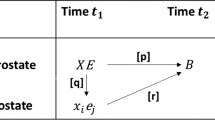Abstract
The paper provides a new critical perspective on the propensity interpretation of fitness (PIF), by investigating its relationship to the propensity interpretation of probability. Two main conclusions are drawn. First, the claim that fitness is a propensity cannot be understood properly: fitness is not a propensity in the sense prescribed by the propensity interpretation of probability. Second, this interpretation of probability is inessential for explanations proposed by the PIF in evolutionary biology. Consequently, interpreting the probabilistic dimension of fitness in terms of propensities is neither a strong motivation in favor of this interpretation, nor a possible target for substantial criticism.
Similar content being viewed by others
Notes
We cannot use Coffa (1977), that is cited by Mills and Beatty, as our reference concerning propensities because it is not about probability and does not define or support a version of the propensity interpretation of probability.
The expected number of offspring is certainly not a good measure of fitness: other parameters, like variance, are relevant too. However, we shall not enter the debate concerning the statistic(s) that should enter measures of fitness: the initial suggestion to the effect of defining fitness in terms of expectation suffices to raise the questions we are interested in. For a critical discussion of the idea that fitness is measured by the expected number of offspring, see Beatty and Finsen (1989), Richardson and Burian (1992), Sober (2001).
Strictly speaking, the disposition of salt to dissolve in water is not deterministic: the probability of dissolution is not 1. However, this probability is extremely close to 1 and the quotation above (p. 271) clearly shows that Beatty and Mills take it to be deterministic.
In particular, some authors argue that disposition ascriptions are just a way of talking about intrinsic properties of objects (Quine 1974; Boyle 1666/1979). Others claim that, although dispositions are more than just names we use to refer to categorical properties, they are causally impotent (O’Shaughnessy 1970; Prior et al. 1982). For a complete review of objections to the view that dispositions are causally efficacious, and for an argument in favour of this view, see Mumford (1998, chapter 6).
It is true that differences in probabilities could appear in the explanation of differences in relative frequencies of various offspring contributions. Think about repeating similar circumstances. Then, the larger the number of repetitions, the higher the probability that the actual amount of offspring will correspond to the expectation. Moreover, the larger a population of similar individuals, the higher the chance that the average number of offspring will be close to the expectation. Those explanatory relations, however, are irrelevant as far as the explanation of differences in individual reproductive success are concerned.
Such an explanation, in any case, is not causal. Among the main kinds of explanation, inductive statistical seems to be the closest.
References
Beatty, J., & Finsen, S. (1989). Rethinking the propensity interpretation: A peek inside the Pandora’s box. In M. Ruse (Ed.), What the philosophy of biology is (pp. 17–30). Dordrecht: Kluwer Academic Publishers.
Boyle, R. (1666/1979). The origin and forms of qualities. In M. A. Stewart (Ed.) Selected philosophical papers of Robert Boyle (pp. 1–96). Manchester: Manchester University Press.
Brandon, R. (1978). Adaptation and evolutionary theory. Studies in the History and Philosophy of Philosophy of Science, 9(3), 181–206.
Brandon, R., & Carson, S. (1996). The indeterministic character of evolutionary theory: No ‘No hidden variables proof’ but no room for indeterminism either. Philosophy of Science, 63(3), 315–337.
Coffa, J. A. (1977). Probabilities: Reasonable or true? Philosophy of Science, 43(2), 186–198.
Eagle, A. (2004). Twenty-one arguments against propensity analyses of probability. Erkenntnis, 60(3), 371–416.
Humphreys, P. (1985). Why propensities cannot be probabilities. Philosophical Review, 94(4), 557–570.
Humphreys, P. (2004). Some considerations on conditional chances. The British Journal for the Philosophy of Science, 55, 667–680.
Kyburg, H. E. (2002). Don’t take unnecessary chances. Synthese, 132(1–2), 9–26.
Mellor, D. H. (1971). The matter of chance. Cambridge: Cambridge University Press.
Mills, S., & Beatty, J. (1979). The propensity interpretation of fitness. Philosophy of Science, 46(2), 263–286.
Mumford, S. (1998). Dispositions. New York: Oxford University Press.
O’Shaughnessy, B. (1970). The powerlessness of dispositions. Analysis, 31(1), 1–15.
Popper, K. (1959). The propensity interpretation of probability. The British Journal for the Philosophy of Science, 10(37), 25–42.
Prior, E. W., Pargetter, R., & Jackson, F. (1982). Three theses about dispositions. American Philosophical Quarterly, 19, 251–257.
Quine, W. V. O. (1974). Roots of reference. Chicago, IL: Open Court Publishing Co.
Railton, P. (1978). A deductive-nomological model of probabilistic explanation. Philosophy of Science, 45(2), 206–226.
Richardson, R. C., & Burian, R. M. (1992). A defense of propensity interpretations of fitness. Philosophy of Science: Proceedings of the Biennal Meeting of the Philosophy of Science Association, 1, 349–362.
Salmon, W. C. (1971). Statistical explanation and statistical relevance. Pittsburgh: University of Pittsburgh Press.
Scriven, M. (1959). Explanation and prediction in evolutionary theory. Science, 30(3374), 477–482.
Sober, E. (2001). The two faces of fitness. In R. S. Singh, C. B. Krimbas, D. B. Paul, & J. Beatty (Eds.), Thinking about evolution: Historical, philosophical, and political perspectives (pp. 309–321). New York: Cambridge University Press.
Author information
Authors and Affiliations
Corresponding author
Rights and permissions
About this article
Cite this article
Drouet, I., Merlin, F. The Propensity Interpretation of Fitness and the Propensity Interpretation of Probability. Erkenn 80 (Suppl 3), 457–468 (2015). https://doi.org/10.1007/s10670-014-9681-2
Received:
Accepted:
Published:
Issue Date:
DOI: https://doi.org/10.1007/s10670-014-9681-2




